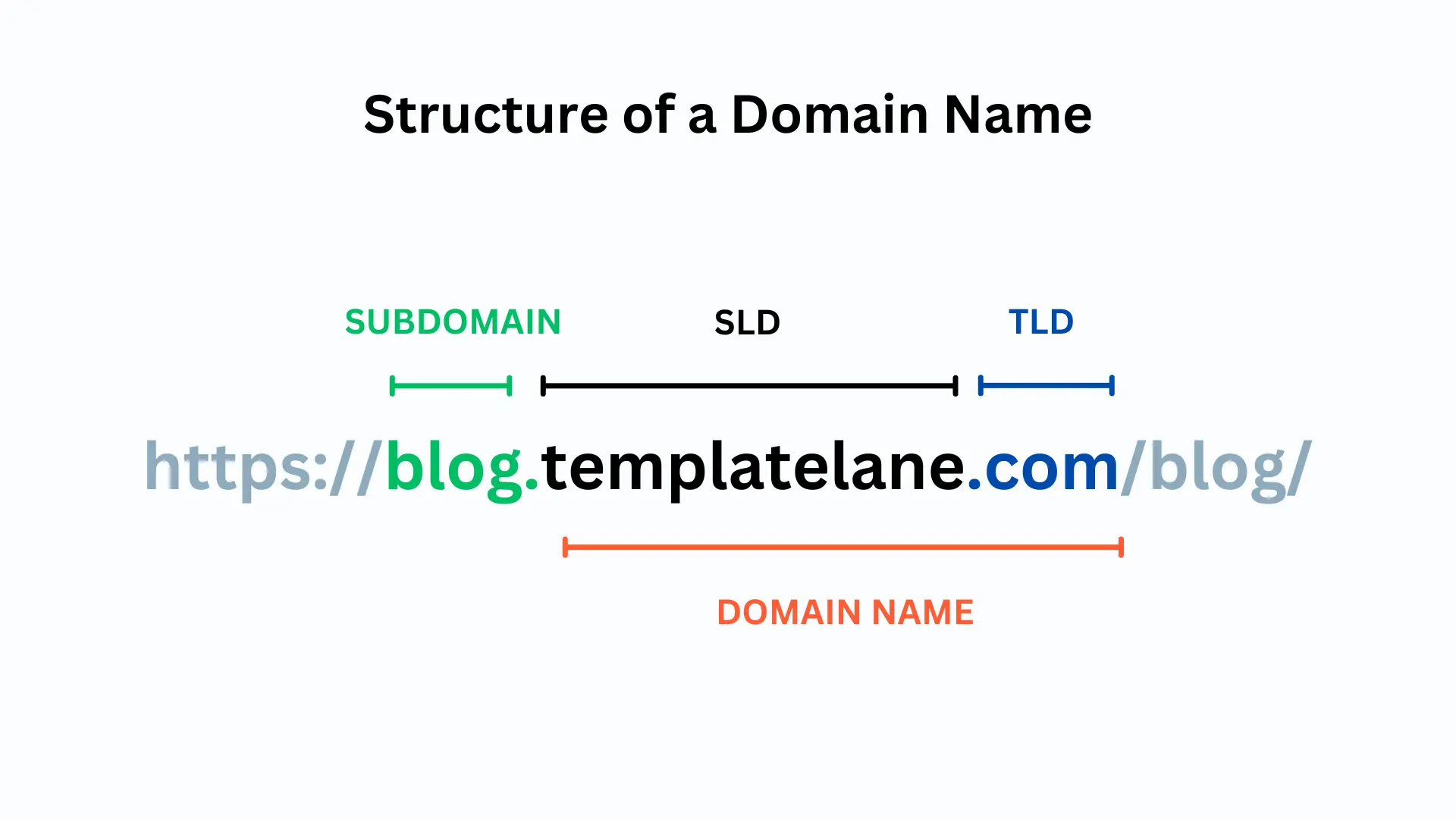Limited Time Offer 👉 Get 58% off Divi AI with the Divi Pro.
What is Domain Names and Web Hosting?

In today’s digital age, having an online presence is crucial for businesses, individuals, and organizations alike. Two fundamental components that make up the backbone of any website are domain name and web hosting. While they are closely interconnected, each serves a distinct purpose in the grand scheme of creating and maintaining a website. In this article, we’ll delve into the specifics of what domain names and web hosting are, how they work, and why they are essential.
Let’s get started!
What is Domain Name?
A domain name is a unique identifier for a website, providing a human-readable address that users can type into their web browsers to reach a specific site. This name is linked to an IP address, a series of numbers that computers use to identify each other on the network. For instance, instead of typing 172.217.16.196, you can simply type www.google.com.
Structure of a Domain Name.

A typical domain name consists of two main parts:
- Subdomain: The portion before the main domain, often ‘www’. Custom subdomains like ‘blog’ or ‘shop’ can be used for specific sections of a website (e.g., blog.templatelane.com).
- Second-Level Domain (SLD): This is the main part of the domain name and usually represents the name of your website or business. For example, in
templatelane.com, “templatelane” is the SLD. - Top-Level Domain (TLD): This is the suffix that follows the SLD, indicating the category or country of the domain. Common TLDs include
.com,.net,.org, and country-specific ones like.ukor.jp.
Domain Name System (DNS)
The DNS is a global system that translates domain names into IP addresses, enabling browsers to locate and load websites. When you enter a domain name into your browser, the DNS servers work behind the scenes to find the corresponding IP address and direct your browser to the correct server where the website is hosted.
What is Domain Extensions?
Domain extensions, also known as top-level domains (TLDs), are the last part of a domain name, appearing after the final dot. They help classify domain names by their purpose, region, or organization type.

Here’s an overview of the different types of domain extensions:
- Generic Top-Level Domains (gTLDs): These are the most common type of TLDs and are not tied to any specific country or region.
- .com – Originally intended for commercial businesses but now widely used by all types of entities.
- .org – Primarily used by non-profit organizations.
- .net – Originally for network-related entities like internet service providers but now used by many types of organizations.
- .info – Intended for informational websites.
- .biz – For business or commercial use.
- .name – For personal use, such as personal blogs or websites.
- .edu – Reserved for educational institutions.
- .gov – Reserved for governmental entities in the United States.
- .mil – Reserved for the United States military.
- Country Code Top-Level Domains (ccTLDs): These are two-letter domain extensions assigned to countries or territories.
- .us – United States
- .uk – United Kingdom
- .ca – Canada
- .de – Germany
- .fr – France
- .cn – China
- .jp – Japan
- .in – India
- Sponsored Top-Level Domains (sTLDs): These are specialized TLDs that are sponsored by specific organizations or communities.
- .aero – For the air transport industry.
- .coop – For cooperatives.
- .museum – For museums.
- .jobs – For employment-related sites.
- .mobi – For mobile-compatible sites.
- .travel – For travel and tourism industry.
- Infrastructure Top-Level Domain: Infrastructure Top-Level Domain.
- .arpa – Used for technical infrastructure purposes (Address and Routing Parameter Area).
- New Generic Top-Level Domains (New gTLDs): Introduced to expand the available domain name space, these can include virtually any term or phrase and often target specific industries, interests, or communities.
- .app – For applications.
- .blog – For blogs.
- .shop – For e-commerce and online stores.
- .tech – For technology-related sites.
- .xyz – A generic extension used for a variety of purposes.
- .guru – For expert sites.
- .club – For clubs and communities.
- Internationalized Domain Names (IDNs): These use non-ASCII characters and allow domain names in various native languages and scripts.
- .中国 (China)
- .рф (Russia)
- .भारत (India)
- Second-Level Domains: Some domains are structured to have an additional layer of categorization under a TLD, especially common in the United Kingdom and Japan.
- .co.uk – Commercial entities in the United Kingdom.
- .ac.uk – Academic institutions in the United Kingdom.
- .gov.uk – Governmental entities in the United Kingdom.
- .co.jp – Commercial entities in Japan.
- .ac.jp – Academic institutions in Japan.
These various domain extensions offer a wide range of choices for website owners, allowing them to select the most appropriate extension based on their location, industry, or purpose.
Key Features of Domain Names:
- Availability: Domain names must be unique. Before registration, it’s essential to check the availability of the desired name.
- Registrar: A domain name must be registered through a domain registrar, accredited by the Internet Corporation for Assigned Names and Numbers (ICANN).
- Renewal: Domain names are typically registered for a specific period, usually one to ten years, and must be renewed to maintain ownership.
- Function: The DNS translates human-readable domain names into IP addresses, allowing browsers to locate and load websites.
- Components: Key DNS components include A records (pointing to the IP address), MX records (mail exchange servers), and CNAME records (canonical name records for aliasing).
- Keywords: Including relevant keywords in a domain name can enhance search engine optimization (SEO), making it easier for users to find the site.
- Length and Memorability: Short, concise, and memorable domain names are preferable. They are easier to type, remember, and less prone to errors.
- Brand Consistency: The domain name should align with the brand, ensuring consistency across online and offline presence.
- SSL Certificates: Secure Sockets Layer (SSL) certificates encrypt data transmitted between the user’s browser and the server, essential for secure transactions and enhancing trust.
- Domain Privacy Protection: Protects the registrant’s personal information from being publicly accessible in the WHOIS database.
- Domain Locking: Prevents unauthorized transfers or changes to the domain name settings.
- Trademark Infringement: It’s crucial to ensure that the domain name doesn’t infringe on existing trademarks, which can lead to legal disputes.
- Cybersquatting: The practice of registering domain names with the intent to sell them at a higher price to the trademark owner is illegal and can result in legal actions.
- Purpose: IDNs allow domain names to include characters from non-Latin scripts, such as Arabic, Chinese, Cyrillic, and others.
- Benefits: Enhances accessibility and usability for users around the world, supporting linguistic and cultural diversity.
- Relevance: The domain name should reflect the website’s content, purpose, or business.
- Uniqueness: Avoid generic names and aim for something distinctive that stands out.
- Future-Proofing: Consider long-term goals to ensure the domain name remains relevant as the business grows or diversifies.
What is a Domain Name Registrar?
A Domain Name Registrar is a company or organization accredited by the Internet Corporation for Assigned Names and Numbers (ICANN) to sell and manage the registration of domain names. Domain names are human-readable addresses (like www.example.com) used to access websites on the Internet. Registrars provide services that allow individuals and organizations to register and maintain these domain names, ensuring they are unique and pointing to the correct web servers.
How Domain Name Registrars Work?
- Accreditation: To become a registrar, a company must be accredited by ICANN or a regional internet registry (such as ARIN, RIPE NCC, APNIC, LACNIC, or AFRINIC).
- Interaction with Registry: Registrars interact with domain registries (organizations managing the top-level domains, such as .com, .org, .net) to register and manage domains. Registries maintain the central database of all domain names and their corresponding information.
- User Interface: They provide an online interface where users can search for, purchase, and manage their domain names.
How to Register a Domain Name?
To register a domain name, you need to go through a domain registrar, an organization accredited by the Internet Corporation for Assigned Names and Numbers (ICANN). Popular registrars include GoDaddy, Namecheap, and Google Domains.
We cannot really purchase a domain name. We simply register it and get it on lease for a specific period, like 1 year, 2 years (up to 10 years). After this time is up, we need to pay a renewal amount in order to keep our domain registration alive. If this amount is not paid, we lose the ownership of the domain and it is free to be purchased by anyone on the Internet! Several companies have ventured into offering lifetime domain registrations with a one-time registration fee, albeit with varying terms and conditions.
The process typically involves:
- Searching for Availability: Use the registrar’s search tool to check if your desired domain name is available.
- Choosing a Domain Name: If your first choice is unavailable, you may need to brainstorm alternative names or consider different TLDs.
- Registration and Payment: Once you find an available domain, you can register it by providing your details and making a payment. Registrations are typically for one year, with the option to renew.
Protecting Your Domain Name.
After registering a domain name, it’s important to protect it from unauthorized changes or transfers. Implementing measures like domain privacy, which hides your contact information from the public WHOIS database, and enabling domain locking, which prevents unauthorized transfers, are crucial steps.
The Future of Domain Names.
As the internet continues to evolve, so too will the domain name landscape. The introduction of new gTLDs and the increasing importance of mobile and voice search will shape how domain names are used and perceived. Ensuring your domain strategy is adaptable to these changes will be key to maintaining a strong online presence.
In conclusion, domain names are an integral part of the internet, serving as the foundation for online identity and navigation. Understanding their structure, importance, and the process of registration and protection can help you make informed decisions that bolster your online presence and credibility.
What is Web Hosting?
Web hosting is a service that provides the necessary infrastructure and technologies for your website to be accessed on the internet. When you purchase a web hosting plan, you are essentially renting space on a server where your website’s files are stored and managed.
Types of Web Hosting:

There are several types of web hosting, each catering to different needs:
- Shared Hosting: Multiple websites share a single server’s resources, making it a cost-effective option for beginners or small websites with low traffic. However, performance can be affected if other websites on the same server experience high traffic.
- VPS Hosting: Virtual Private Server (VPS) hosting provides a dedicated portion of a server’s resources, offering more control and better performance than shared hosting. It’s suitable for medium-sized websites that need more reliability.
- Dedicated Hosting: You get an entire server dedicated to your website, offering the highest level of performance and control. This option is best for large websites with high traffic and complex needs, but it comes at a higher cost.
- Cloud Hosting: Websites are hosted on a network of interconnected servers, providing scalability and reliability. If one server goes down, another takes over, ensuring minimal downtime. This is ideal for websites that experience fluctuating traffic.
- Managed Hosting: This service includes maintenance and management of your server by the hosting provider, allowing you to focus on your website’s content and business operations. It’s a great option for those who prefer a hands-off approach to technical aspects.
How Does Web Hosting Work?
- Server Space: When you create a website, its files, such as HTML, images, and videos, need to be stored somewhere. Web hosting companies allocate space on their servers for these files.
- Domain Name: Your website also needs an address so users can find it. This is your domain name (e.g., www.example.com), which you purchase from a domain registrar. The domain name is then linked to your web hosting server.
- Accessibility: Once your website is hosted and connected to a domain name, users can access it by typing your domain into their web browser. The browser then retrieves the website’s files from the server and displays the content.
Key Features of Web Hosting:
- Reliability: Professional web hosting ensures that your website is always accessible with minimal downtime, enhancing user experience and trust.
- Security: Features like SSL certificates, firewalls, malware protection, and regular backups protect your website from threats and data loss.
- Storage: The amount of space allocated on the server to store your website’s files, databases, and media.
- Bandwidth: The amount of data that can be transferred between your website and its visitors. Higher bandwidth ensures better performance during high traffic.
- Uptime: The percentage of time your website is accessible online. Look for hosts that offer at least 99.9% uptime.
- Support: Quality customer support can help resolve technical issues swiftly, ensuring minimal disruption to your website’s operations.
- Scalability: Hosting services can be easily scaled up or down based on the website’s traffic and resource needs, accommodating growth and changes in demand.
How Domain Names and Web Hosting Work Together?
Once you have a domain name and a web hosting plan, the next step is to link them together. This process involves updating your domain’s DNS settings to point to your web host’s servers. Here’s a simplified breakdown of the process:
- Domain Name Registration:
- Choose and register your domain name through a domain registrar.
- Ensure it is memorable, relevant to your brand, and preferably easy to spell and pronounce.
- Select a Web Hosting Service:
- Choose a right web hosting provider based on your website’s needs, such as expected traffic, type of content, and technical requirements.
- Purchase a hosting plan and set up your hosting account.
- Linking Domain Name to Web Hosting:
- After purchasing both a domain names and a web hosting service, you need to link them together.
- Update the Domain Name System (DNS) settings of your domain. This involves pointing the domain to the hosting provider’s servers.
- DNS settings are usually updated through the domain registrar’s control panel, where you enter the nameservers provided by your hosting provider.
- Uploading Website Files:
- With the domain and hosting connected, you can upload your website files to the hosting server.
- This can be done using a control panel provided by your hosting service (like cPanel) or via an FTP client.
- Accessing Your Website:
- Once the DNS changes propagate (which can take up to 48 hours), typing your domain name into a web browser will direct users to your website hosted on the server.
Why Both Are Essential?
Without a domain name, users would have to remember numerical IP addresses to visit websites, which is impractical. Without web hosting, your website would have no place to reside and wouldn’t be accessible online. Together, they form the backbone of your online presence, making it easy for users to find and interact with your site.
Tips for Choosing Domain Names and Hosting Providers:
- Domain Name:
- Keep it short and simple.
- Avoid numbers and hyphens.
- Use keywords relevant to your business or niche.
- Web Hosting Provider:
- Check reviews and uptime guarantees.
- Consider customer support quality.
- Evaluate scalability options for future growth.
Conclusion
Understanding the roles of domain names and web hosting is crucial for anyone looking to establish an online presence. The domain name is your website’s address, making it easy for users to find you, while web hosting provides the necessary infrastructure to store your website’s content and make it accessible online. By carefully selecting and configuring both, you can ensure a reliable and professional online presence for your business or personal brand.







